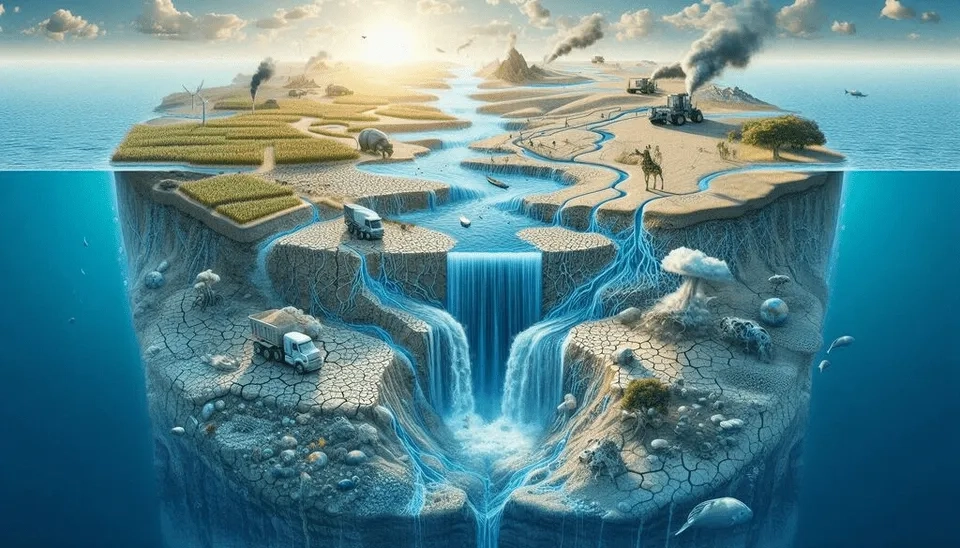
Did you know that the world is slowly sinking? Are humans able to reduce 2 mm of the level under their feet every year? The answer is yes! How? Groundwater withdrawal and depletion. As much as groundwater is necessary for our life, it can be considered as a threat and challenge for us with excessive consumption. We are here to raise your awareness about this!
The importance of groundwater is not hidden from anyone. However, past studies show that 6 to 20% of groundwater wells are not more than 5 meters deeper than the water table. This means that millions of wells are at risk of drying up if the groundwater level drops just a few meters more (Jasechko and Perrone, 2021). This evidence indicates groundwater depletion. Continuing the current rate of withdrawal at an alarming pace will pose numerous direct and indirect challenges.
Groundwater depletion is the long-term extraction of groundwater from an aquifer in such a way that the amount of extraction exceeds the average annual recharge and leads to a continuous decrease in the level and volume of groundwater. Here, groundwater depletion is a long-term and steady-state process. Because the increase in groundwater extraction is associated with a partial recovery period in the short term to improve the aquifer condition with recharge (Scanlon et al., 2012). However, long-term groundwater depletion is not recoverable and will have irreversible consequences.
Groundwater depletion is evident all over the world, and in a country like the United States, it can cause storage depletion and affect the economy, agriculture, and health of a society, which needs to face its causes on a local and regional scale (Konikow, 2014). In this article, we will deal with groundwater depletion consequences to deal with it through a broader perspective.
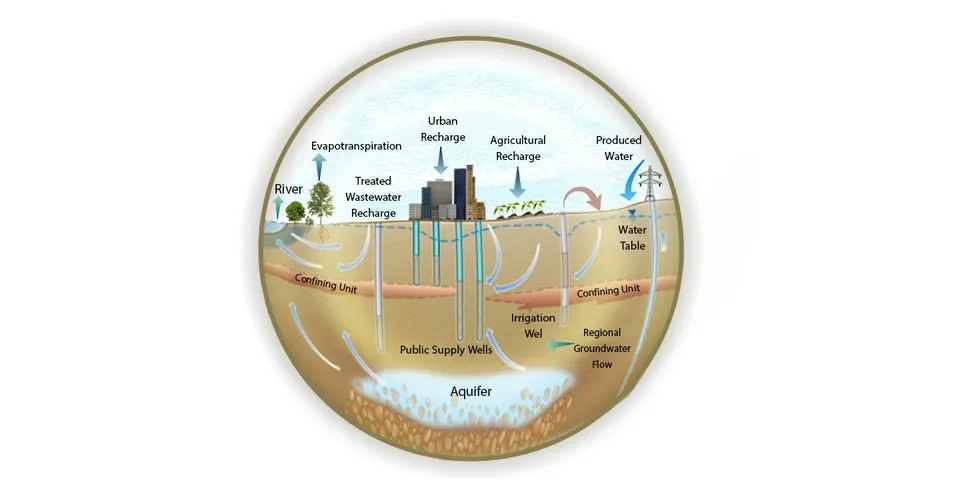
1. Groundwater Withdrawal and Depletion
Climate change, increase in population, increase in demand for food, significant expansion of agriculture, development of urbanization, economic development, and food changes are all factors that have caused an increase in water consumption per capita, both in terms of real water consumption and virtual water. As a result, the amount of water withdrawn for human needs has increased significantly during the last century (Hanasaki et al., 2018). The expansion of water-based agriculture, especially in semi-arid and arid regions with limited rainfall and surface water, has greatly increased the dependence of agriculture on groundwater harvesting. The drought has compelled even regions partially reliant on surface water for irrigation to turn to groundwater sources. As a result, the amount of groundwater reduction has increased over the past decades and will continue in the coming decades. Although excessive consumption of groundwater was first raised almost two decades ago, the true extent of groundwater use has only become public knowledge in the last decade, when the first analyses from Gravity Recovery and Climate Experiment (GRACE) vividly illustrated groundwater depletion (Wada et al., 2010).
2. Groundwater Depletion Consequences
Despite the great importance of groundwater, excessive consumption of groundwater has caused these valuable resources to bring serious challenges to humans and other ecosystems. Next, we will discuss 7 adverse groundwater depletion effects (Bierkens and Wada., 2019).
2.1. Land Subsidence
Subsidence is a phenomenon that occurs when the surface of the earth goes down under the influence of solid or fluid movement (mainly water) due to many natural and human factors. The main cause of ground subsidence is the slow and gradual decrease of groundwater. Therefore, subsidence is accompanied by a large time scale (months to years) and a wide spatial scale (tens to thousands of square meters), which leads to a gradual decrease in the level of the earth's surface (centimeters to decimeters per year). Continuous consumption of groundwater around the world has caused large areas (especially urban and agricultural areas) to be prone to subsidence. Spatial analysis of subsidence shows that subsidence is more prone in very flat areas where unconsolidated sediments have accumulated in alluvial basins or coastal plains, and agricultural or urban areas located in temperate or arid climates with prolonged dry periods. Subsidence is generally more abundant and significant in basins under water stress; Because in these areas, the natural extraction and discharge of groundwater exceeds its supply and leads to loss of groundwater storage, discharge, and condensation of the aquifer. Subsidence has many destructive effects. Subsidence reduces the storage capacity of the aquifer and damages the infrastructure (underground pipes, roads, bridges, and buildings) by creating cracks in the ground. Also, subsidence increases the risk and vulnerability of floods with the failure of related dikes. In the future, population growth and economic growth will lead to an increase in groundwater demand and excessive consumption of groundwater. As the intensity and frequency of drought increases, the probability of land subsidence and related damages will also increase (Herrera-García et al., 2021).
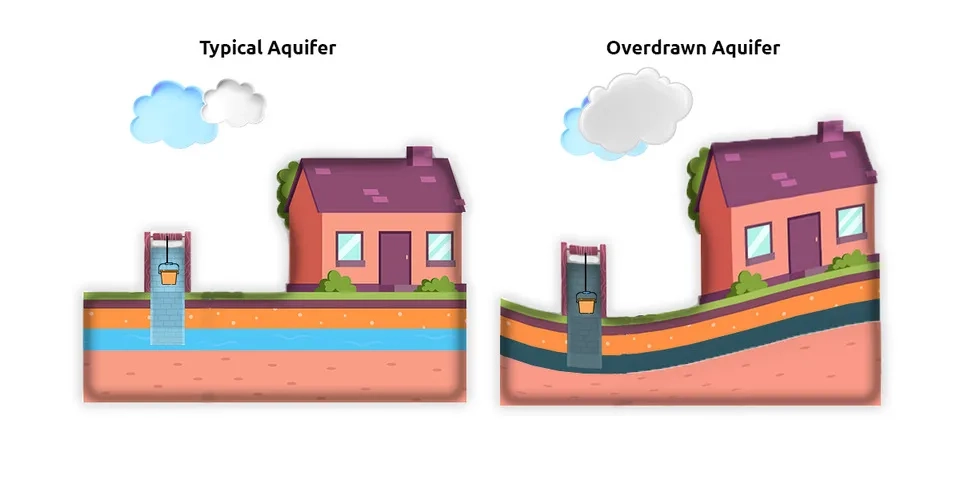
2.2. Groundwater Salinization
The increase in water demand and its excessive exploitation have affected the quality of groundwater in many aquifers. Salinity is one of the qualitative parameters of groundwater that reduces the quality and productivity of groundwater (Mirzavand et al., 2020). Aquifer systems are resources in which the possibility of increasing salinity levels grows with greater depth. Therefore, fresh groundwater (Total Dissolved Solids concentration or TDS less than 1 g/L) is expected to exist at 100 to 500 meters above the aquifer, and brackish groundwater (TDS between 1 and 10 g/L), saline (TDS between 10 and 35 g/L) or hyper-saline (TDS more than 35 g/L) at greater depths. In some areas, brackish or saline groundwater can exist at shallow depths. Groundwater pumping in areas with saline groundwater at shallow depths, due to the reduction of groundwater pressure under the pumping well, can lead to an increase in the interface between fresh and saline groundwater and, as a result, the salinization of groundwater sources. If there is saline groundwater below the level of the well, the extraction of groundwater leads to the inactivity of the well in a short period and makes the groundwater unsuitable for further use. As a result, areas with heavy groundwater extraction and shallow saline groundwater, especially coastal aquifers, are very susceptible to groundwater salinization, which can turn them into a global disaster if continued groundwater consumption (Van Weert et al., 2009).
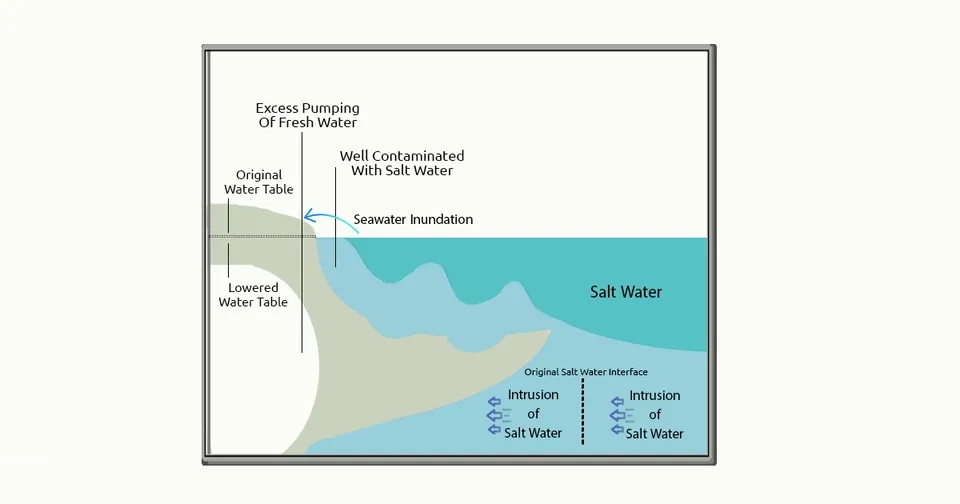
2.3. Negative Effects on Groundwater Ecosystems
Groundwater discharge affects ecosystems that depend on groundwater or near the water surface. Eamus et al., 2016 divide the ecosystems dependent on groundwater into three categories: 1) Ecosystems located in the groundwater itself (e.g. stygofauna in caves, fissures); 2) ecosystems that require surface groundwater (springs, lakes, streams, wetlands); and 3) ecosystems that depend on the availability of groundwater at the rooting depth of vegetation (e.g., forests, coastal). On the other hand, the mentioned three categories of ecosystems are separated into two categories: aquatic ecosystems (inland) and terrestrial ecosystems (coastal).
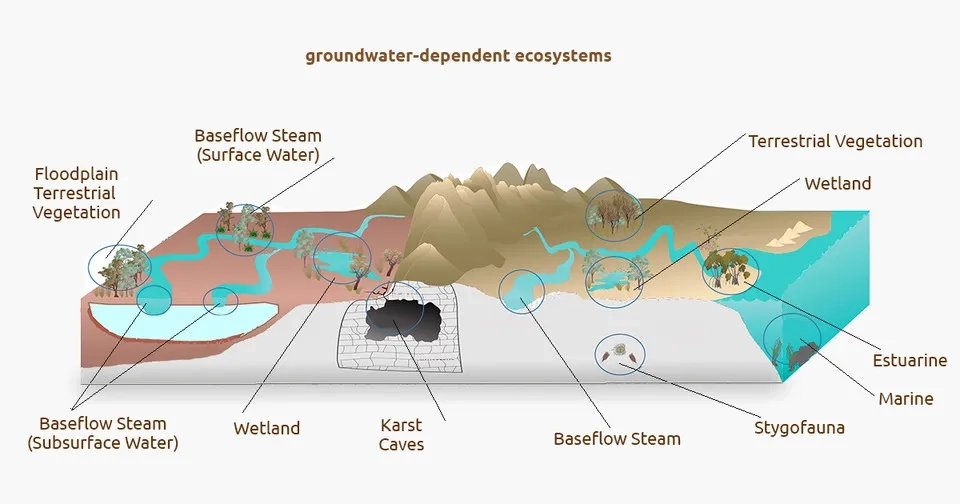
Groundwater discharges are often nutrient-poor and affect temperature, pH, and other streamflow characteristics. The difference in groundwater and streamflow characteristics directly affects the river water chemistry and indirectly through biogeochemical processes on the mixing of groundwater and surface water. Therefore, in addition to affecting the ecosystems by changing the flow regimes, groundwater extraction leads to changes in the quality of river water and aquatic ecosystems (Merill and Tonjes, 2014).
2.4. Hydrological Drought
Meteorological drought is a prolonged period with less than normal rainfall. Meteorological drought manifests itself through the hydrological system by creating abnormal soil moisture and evaporation, reducing groundwater recharge and low water levels, and ultimately reducing groundwater discharge to streams, resulting in very low water flow (hydrological drought). As the over-abstraction of groundwater affects groundwater discharge, it may also increase the severity and frequency of hydrological drought. For example, the drastic reduction of groundwater is a possible reason for summer flow drying, which causes other environmental problems such as the reduction of water quality (Tallaksen and Van Lanen, 2004).
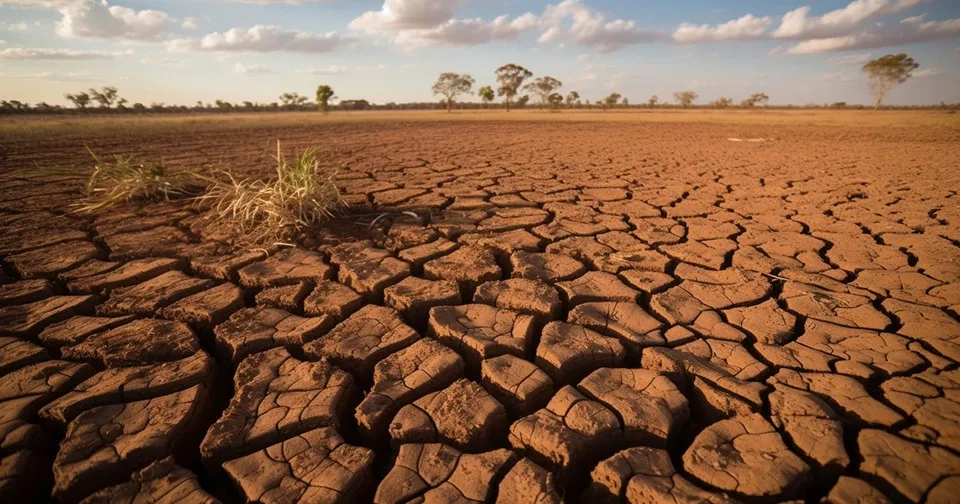
2.5. Impacts on Agriculture and Food Chain
Groundwater is one of the most important sources of irrigation and the production of agricultural products. Excessive consumption of groundwater resources in many regions of the world has affected the crop yield, area, and production of agricultural products. During rainy seasons, when water resources are available through rainfall and surface irrigation, groundwater depletion mostly does not affect yield, area, and major crop production (except for water-intensive crops such as rice). But groundwater depletion consequences on the production of agricultural products in summer and dry winter seasons are very impressive; Because in this period, there is little rainfall for water crops and the main source of irrigation is groundwater, which causes farmers to spend more effort and money to extract water from deeper depths as the water level falls. Therefore, the results of the studies show that although the area under cultivation of water-rich crops has decreased (albeit by a small amount) with the reduction of the water level, the farmers invest heavily in high-capacity pumps instead of improving cropping patterns, which exacerbates groundwater depletion. Furthermore, excessive consumption of groundwater causes the expansion of rain-fed agriculture, the shift of production of water products to more water-rich areas, the impact on international trade, and the sustainability of agriculture. Accordingly, groundwater withdrawal and depletion for irrigation can affect the food chain and security significantly (Dalin et al., 2019; Turner et al., 2019).
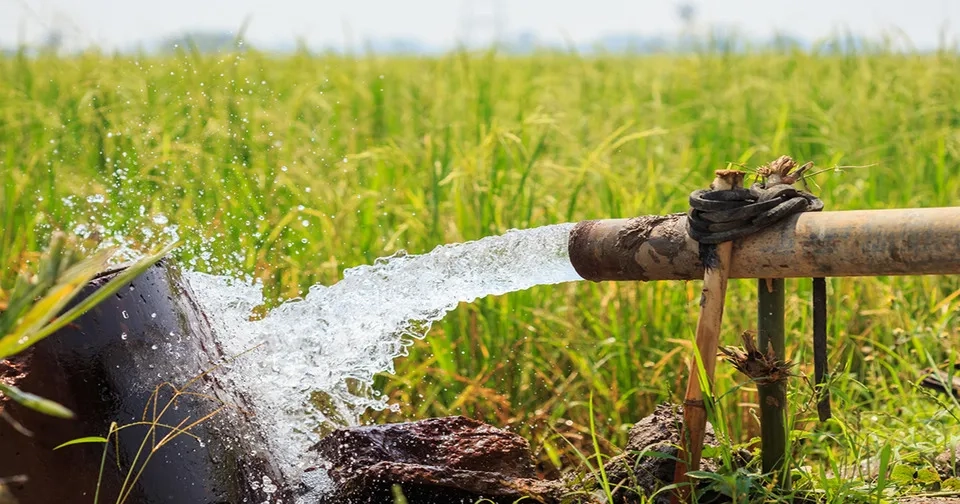
2.6. Sea Level Rise
Another consequence of groundwater depletion is sea level rise. Sea level rise is mainly attributed to thermal expansion and ice caps, glaciers, and ice sheets melting. Deep and dormant fossil groundwaters have been separated from the hydrological cycle for hundreds to thousands of years, depending on the storage volume, recharge, and discharge rates. However, the discharge of groundwater for agriculture and other uses through the continuous reduction of dormant groundwater and deep fossil groundwater and its transfer to fresh water on the surface of the earth, makes the hydrological cycle on the surface more active. Water stored on land and intensification of the hydrological cycle contribute to more ocean storage and sea level rise(Wada, 2016).

2.7. Effect on Flow Exchange and Streamflow
Groundwater depletion moves the groundwater level to a dynamic equilibrium point at a lower level. The reduction of the groundwater levels near the pumping is more significant than the distant points, however, it is also possible at far distances. Previous studies show that the reduction of groundwater affects the reduction of surface discharge and the reduction of seasonal variability of streamflow (Lapides et al., 2022). In addition to reducing the magnitude of the streamflow, groundwater depletion can also affect the temperature of the streamflow, which is more significant in low-flow regions. The interaction of streamflow and groundwater has made it more important and vital to integrate environmental flow approaches and groundwater harvesting strategies into hydrological-groundwater models (Condon and Maxwell, 2019).
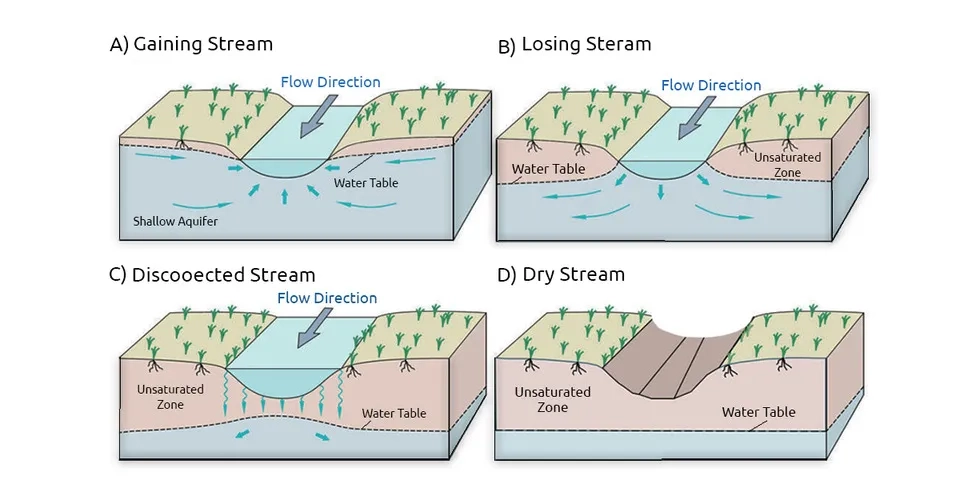
3. Conclusion
Groundwater is a valuable source of water supply. Population growth, industrialization, and agricultural development have caused groundwater to be rapidly extracted and consumed, which imposes adverse consequences on humans and the ecosystem. In this article, we examined seven groundwater depletion consequences (land subsidence, groundwater salinization, effects on groundwater ecosystems, hydrological drought, impacts on agriculture and food chain, sea level rise, and effect on flow exchange and streamflow). The challenges related to groundwater depletion require special attention to prevent its effects from intensifying further by monitoring the groundwater and adopting sustainable policies and strategies.

